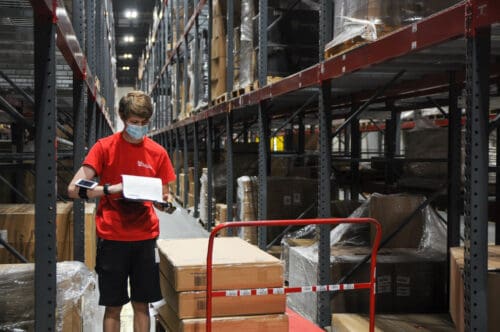Poor delivery performance is costing suppliers millions in retailer penalties while destroying customer relationships.
Retailers now demand near-perfect delivery performance, imposing brutal financial penalties for failures. Major retailers restrict accounts, charge hefty fees, and reduce shelf space allocation for poor performers.
On-time in-full (OTIF) has become the make-or-break metric determining supplier success. This unforgiving measurement requires both perfect timing AND complete quantities—partial success equals total failure.
This guide shows you exactly how to master it.
You’ll discover proven calculation methods, industry benchmarks, root causes destroying your OTIF scores, and specific improvement strategies that drive measurable ROI—from real-time visibility technology to supplier collaboration frameworks.
What you’ll learn

How to calculate OTIF scores and avoid common measurement pitfalls using proven supply chain operations techniques

Industry-specific OTIF benchmarks and retailer requirements for 2025 based on supply chain performance standards

Root causes of poor OTIF performance and proven improvement strategies for supply chain efficiency

Technology solutions including ERP systems for tracking and optimizing delivery reliability across your entire supply chain

TL;DR:
Key takeaways

OTIF requires both on-time delivery AND complete order quantities—partial success counts as failure for this supply chain metric

Walmart’s 98% OTIF requirement with 3% penalty drives industry benchmarks and OTIF standards

Top-performing companies achieve 95-98% OTIF score through integrated supply chain operations and real-time visibility

Systematic improvement approaches deliver measurable ROI when organizations improve OTIF performance
OTIF explained
Understanding on-time in-full requires examining both its definition and the strategic context driving its importance in modern supply chain operations. This supply chain metric has become the gold standard for measuring delivery reliability because it captures what customers actually need: products that arrive when promised and in the quantities ordered. OTIF serves as a comprehensive measure of supply chain performance across multiple dimensions.
Definition in plain English
On-time in-full measures supply chain reliability by evaluating two essential criteria simultaneously: timing accuracy and quantity completeness. Products must arrive within the agreed delivery window while delivering complete order quantities without shortages or substitutions. This supply chain metric reflects the business’s ability to meet customer expectations consistently.
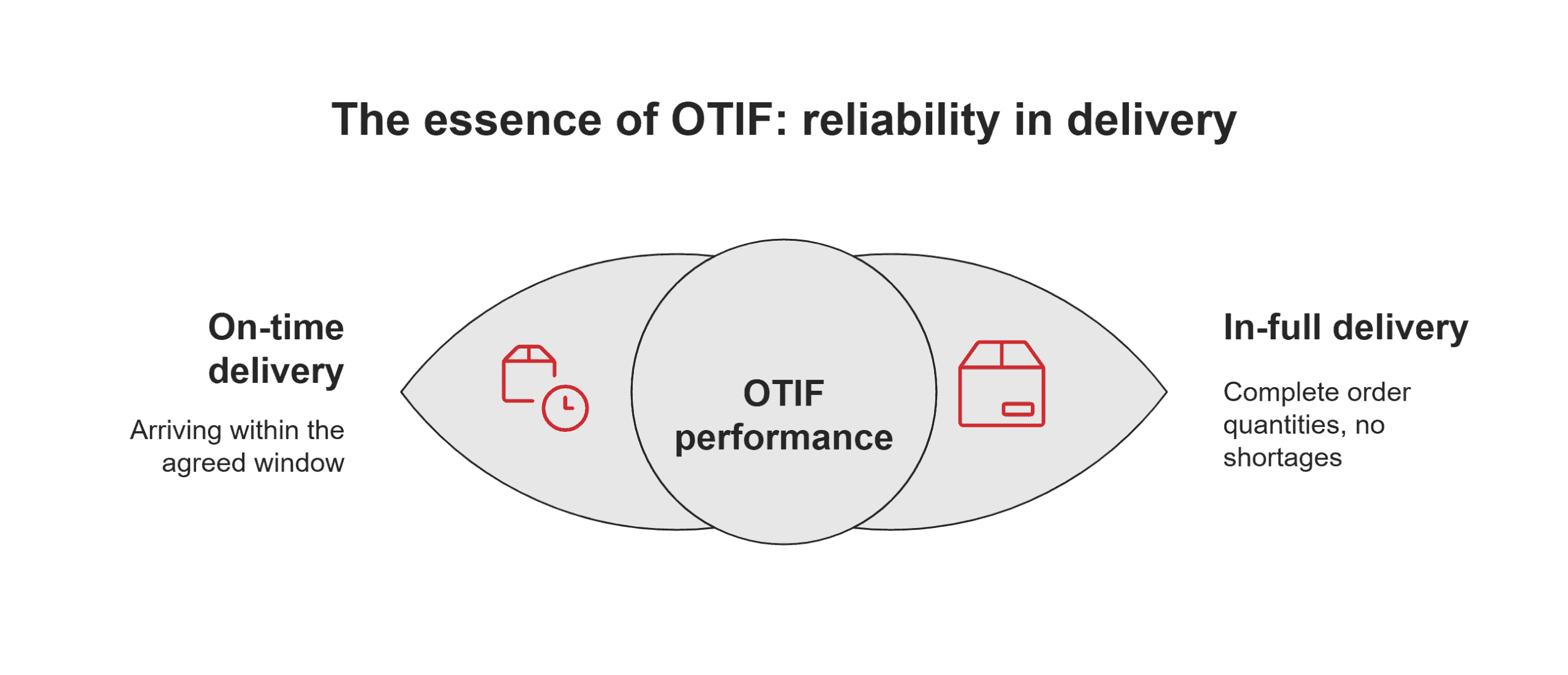

NOTE: OTIF combines these metrics because customers need both timing reliability and quantity accuracy to maintain their operations and satisfy end consumers.
A shipment must meet both criteria to achieve on-time in-full success. Deliveries arriving on schedule but with missing items fail OTIF requirements, just as complete deliveries arriving outside the specified window would fail. This all-or-nothing approach reflects the reality that partial success often equals complete failure in customer operations and supply chain management.
Why Walmart made OTIF a big deal
Walmart revolutionized supplier performance measurement in 2017 by implementing comprehensive on-time in-full requirements that transformed industry benchmarks. The retail giant’s program steadily increased expectations from 75% in August 2017 to the current 98% requirement established in 2020, setting new OTIF standards across supply chain operations.
The financial stakes are enormous. Walmart charges suppliers 3% of the cost of goods sold for each OTIF failure, creating significant financial penalties across the consumer packaged goods industry. This penalty structure forced suppliers to fundamentally rethink their supply chain management, as companies that previously considered acceptable delivery performance suddenly faced significant annual penalties unless they achieved near-perfect OTIF scores.
OTIF vs. fill rate, OTD, DIFOT
While OTIF shares similarities with other supply chain performance measurements, key distinctions clarify its unique value. Fill rate measures order fulfillment from available inventory, focusing on stock availability rather than delivery timing. On-time delivery (OTD) evaluates only timing accuracy without considering order completeness. Delivery in-full on-time (DIFOT) represents a similar concept but may use different calculation methodologies and OTIF metrics.
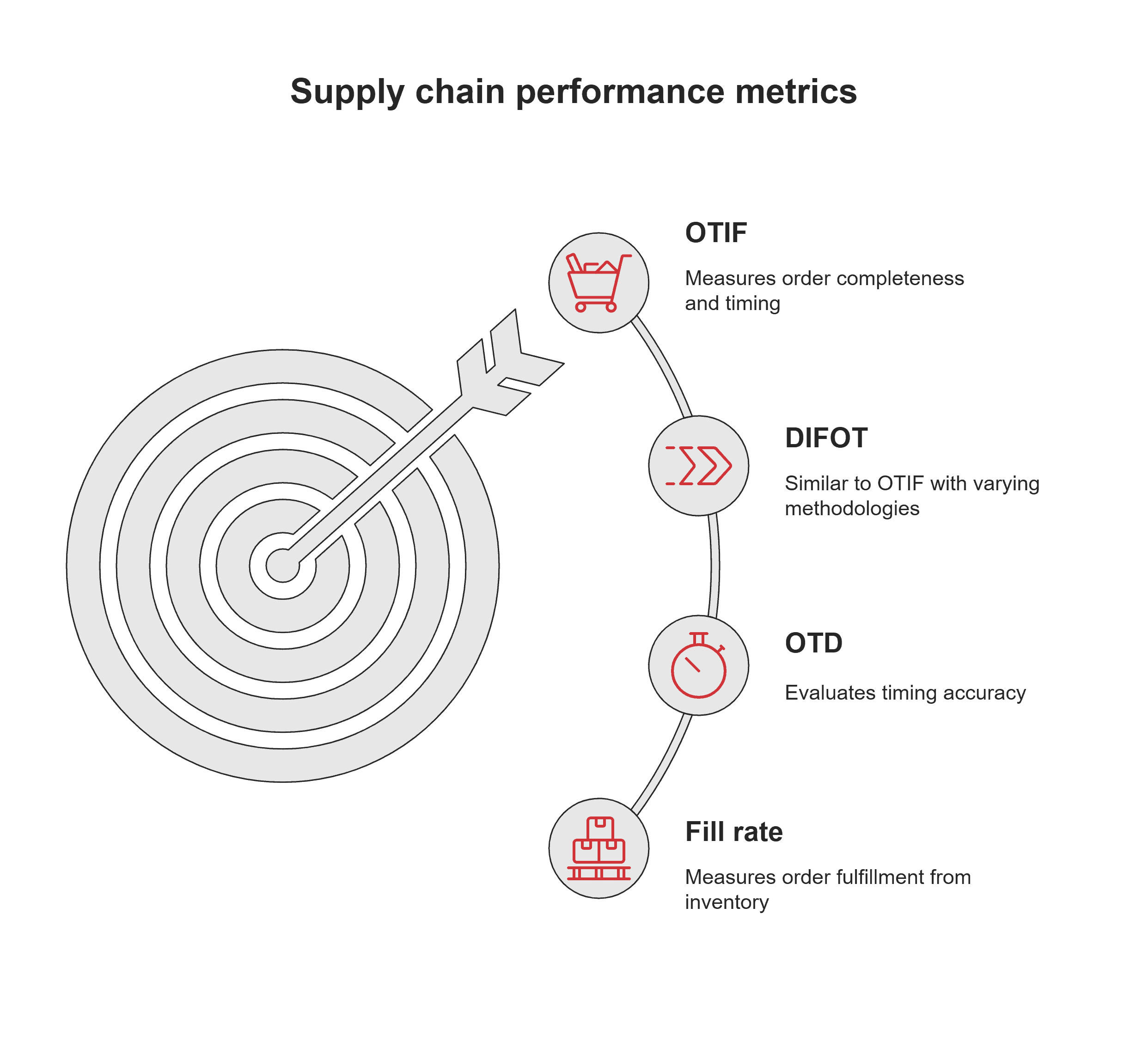
OTIF’s comprehensive approach requires both criteria for success, providing a complete picture of delivery reliability that aligns with customer expectations and supply chain efficiency goals.
How to calculate OTIF
Accurate OTIF measurement requires careful data collection and consistent calculation methodology that eliminates ambiguity and ensures reliable performance tracking. Organizations must measure OTIF consistently to establish meaningful OTIF metrics and monitor supply chain performance effectively.
Formula with worked example
The OTIF calculation follows a straightforward but unforgiving formula that demands perfection in both timing and quantity:
OTIF (%) = (orders delivered on-time and in-full ÷ total orders) × 100
Here’s how this works in practice with a monthly analysis of 100 customer orders:

90 orders: On-time and complete ✓

5 orders: Late but complete ✗

3 orders: On-time but short ✗

2 orders: Late and short ✗
OTIF calculation: 90 ÷ 100 × 100 = 90%
Only orders meeting both criteria count toward OTIF success, regardless of partial achievements. This OTIF score calculation method ensures accurate supply chain performance measurement.

PRO TIP: Establish consistent delivery window definitions between your organization and customers to avoid measurement disputes and ensure accurate performance tracking when you measure OTIF.
Data requirements and common pitfalls
Accurate OTIF tracking requires comprehensive data integration across multiple systems within your supply chain operations. Organizations must capture order timestamps and delivery window specifications, actual delivery confirmations with precise timing, ordered quantities by SKU, delivered quantities with shortage documentation, and customer-specific delivery requirements. ERP systems play a crucial role in maintaining data integrity and enabling real-time data access for monitoring OTIF performance.
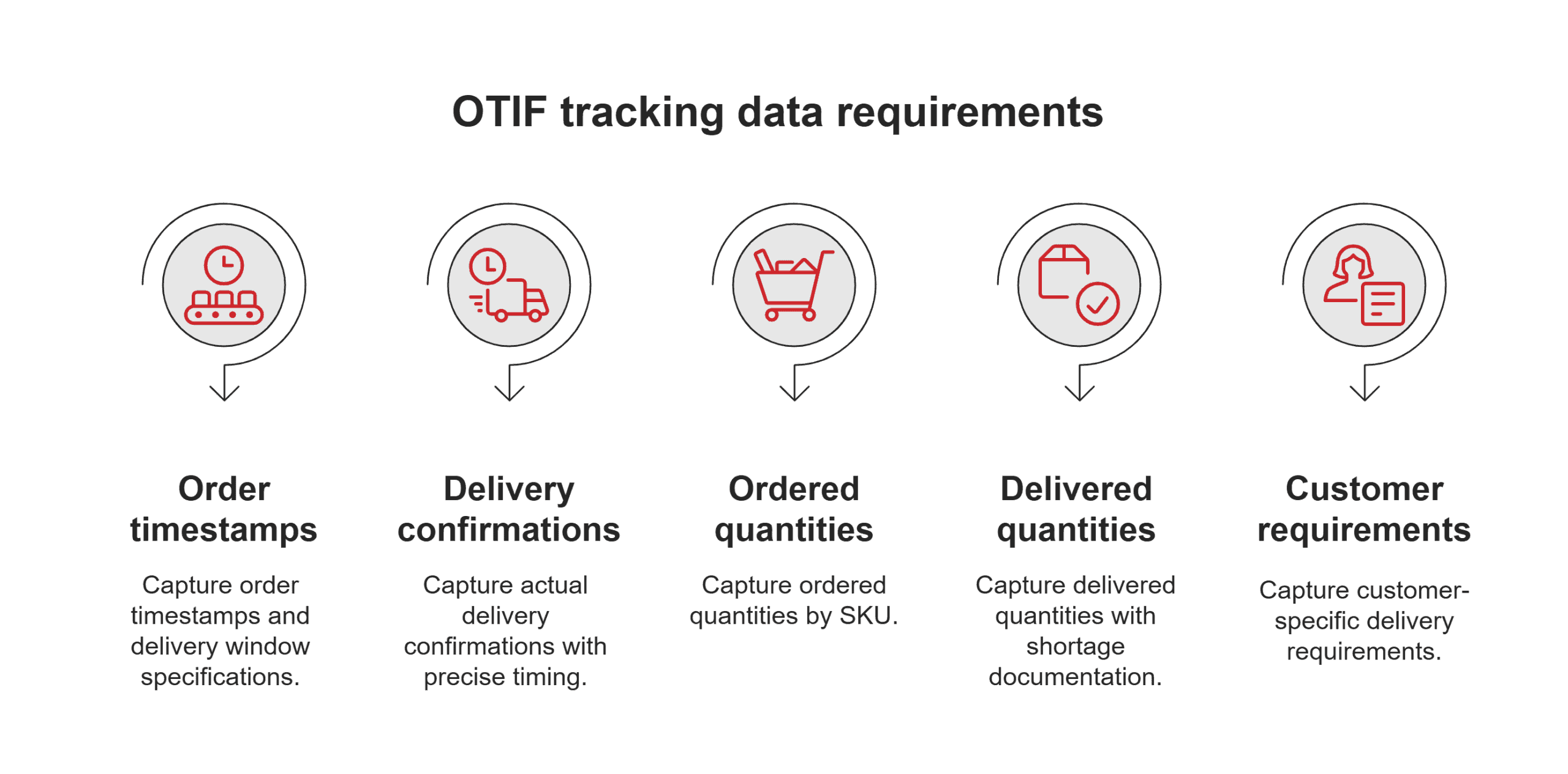
Common calculation errors include inconsistent window definitions between customers and suppliers, early delivery penalties when customers penalize early arrivals, fragmented data missing information from carrier systems, measurement level confusion mixing order-level and line-item calculations, and incomplete data integration across distribution centers and multiple locations.
OTIF calculation template
Organizations need standardized templates to ensure consistent measurement across different teams and time periods. Essential components include customer identification and delivery requirements, order numbers with line-item details, promised delivery dates and actual confirmations, ordered versus delivered quantities by SKU, and clear success/failure indicators for both timing and quantity criteria. These templates help establish reliable OTIF metrics and support effective supply chain management practices.
What is a good OTIF benchmark in 2025?
Setting realistic OTIF targets requires understanding industry benchmarks and customer expectations that vary significantly across sectors and market segments. A good OTIF benchmark depends on supply chain complexity, customer requirements, and operational excellence standards within your industry.
Industry-specific ranges
OTIF performance expectations differ dramatically based on industry characteristics, supply chain complexity, and customer requirements:
| Industry | Good OTIF score | Excellent OTIF score | Key factors |
|---|---|---|---|
| Consumer goods | 85-90% | 95-98% | Retailer requirements, shelf space |
| Food & beverage | 80-85% | 90-95% | Perishability, cold chain |
| Automotive | 90-95% | 98-99% | Just-in-time manufacturing |
| Pharmaceuticals | 85-90% | 95-98% | Regulatory compliance |
| Industrial | 80-90% | 90-95% | Complex supply chains |
| Ecommerce | 85-90% | 92-97% | Customer experience focus |
These industry benchmarks reflect that different sectors face unique supply chain challenges. Automotive suppliers must achieve near-perfect OTIF scores to support just-in-time manufacturing, while industrial companies dealing with complex global supply chain operations may accept slightly lower performance levels. Understanding these OTIF standards helps organizations set realistic OTIF goals, particularly when working with specialized ecommerce fulfillment providers who understand industry-specific requirements.
Retailer expectations
Major retailers have established specific on-time in-full requirements that suppliers must meet to maintain partnerships. Walmart maintains its 98% OTIF target with a 3% penalty on the cost of goods sold for failures. Amazon expects at least 90% OTIF performance across categories with potential account restrictions. For suppliers looking to optimize their Amazon operations, partnering with the best 3PL for Amazon can significantly improve OTIF performance through specialized expertise and technology integration.

NOTE: Retailer-specific requirements often include unique delivery window definitions, early delivery penalties, and specialized measurement methodologies that suppliers must understand and accommodate in their supply chain management processes.
Root causes of low OTIF scores
Identifying OTIF failure sources enables targeted improvement strategies that address underlying problems rather than symptoms. Most low OTIF scores stem from predictable causes within supply chain operations that organizations can systematically address. Understanding these root causes is essential to improve OTIF performance and avoid late or incomplete deliveries.
Supplier issues
Unreliable suppliers create significant OTIF challenges through inconsistent delivery schedules, quality problems requiring returns, inadequate capacity planning, and poor communication regarding order changes. The supplier’s ability to meet commitments directly impacts your OTIF score and overall supply chain performance. Effective supplier collaboration requires regular performance reviews with clear consequences, comprehensive service level agreements with specific OTIF requirements, backup supplier arrangements, and collaborative planning processes that enhance supply chain efficiency.
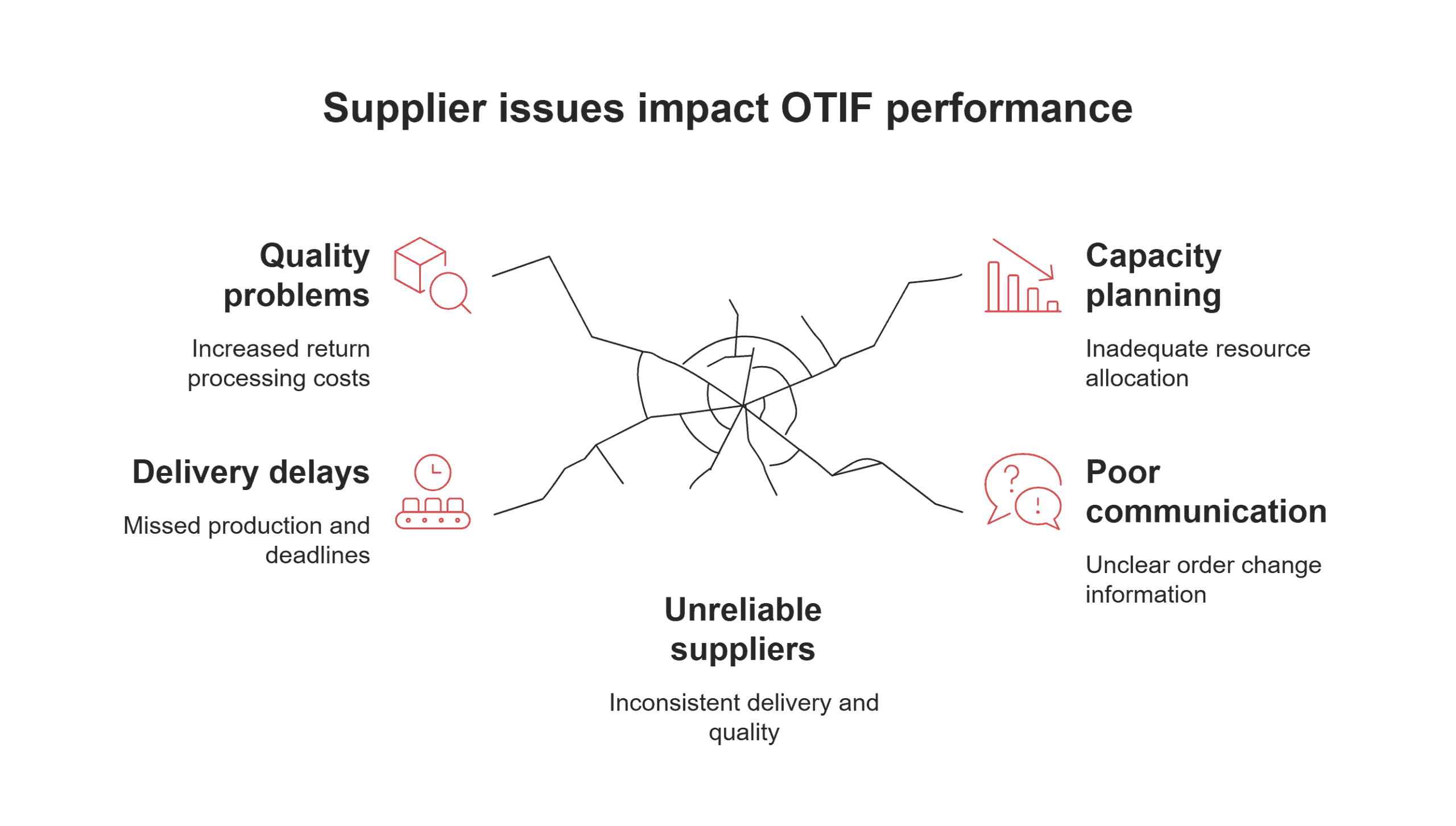
Inventory and forecast errors
Inaccurate demand planning leads to inventory imbalances that prevent complete order fulfillment even when timing is perfect. Root causes include poor data quality in forecasting systems, inadequate forecasting models that miss seasonal patterns, insufficient market intelligence, and improper safety stock calculations that fail to account for demand variability. Maintaining optimal inventory levels and reducing lead time variability are crucial for achieving good OTIF scores and effective supply chain management.
Transportation and yard bottlenecks
Logistics issues frequently disrupt OTIF through inadequate carrier capacity during peak periods, routing inefficiencies, yard congestion, and poor shipment visibility. These bottlenecks result in delayed shipments and impact the entire supply chain’s ability to achieve OTIF targets. For companies dealing with big and heavy fulfillment requirements, specialized handling and transportation capabilities become even more critical to maintaining OTIF performance. Effective solutions include yard management systems that optimize dock scheduling, route optimization software, carrier scorecards, and real-time visibility capabilities that help minimize delays and improve operational efficiency.
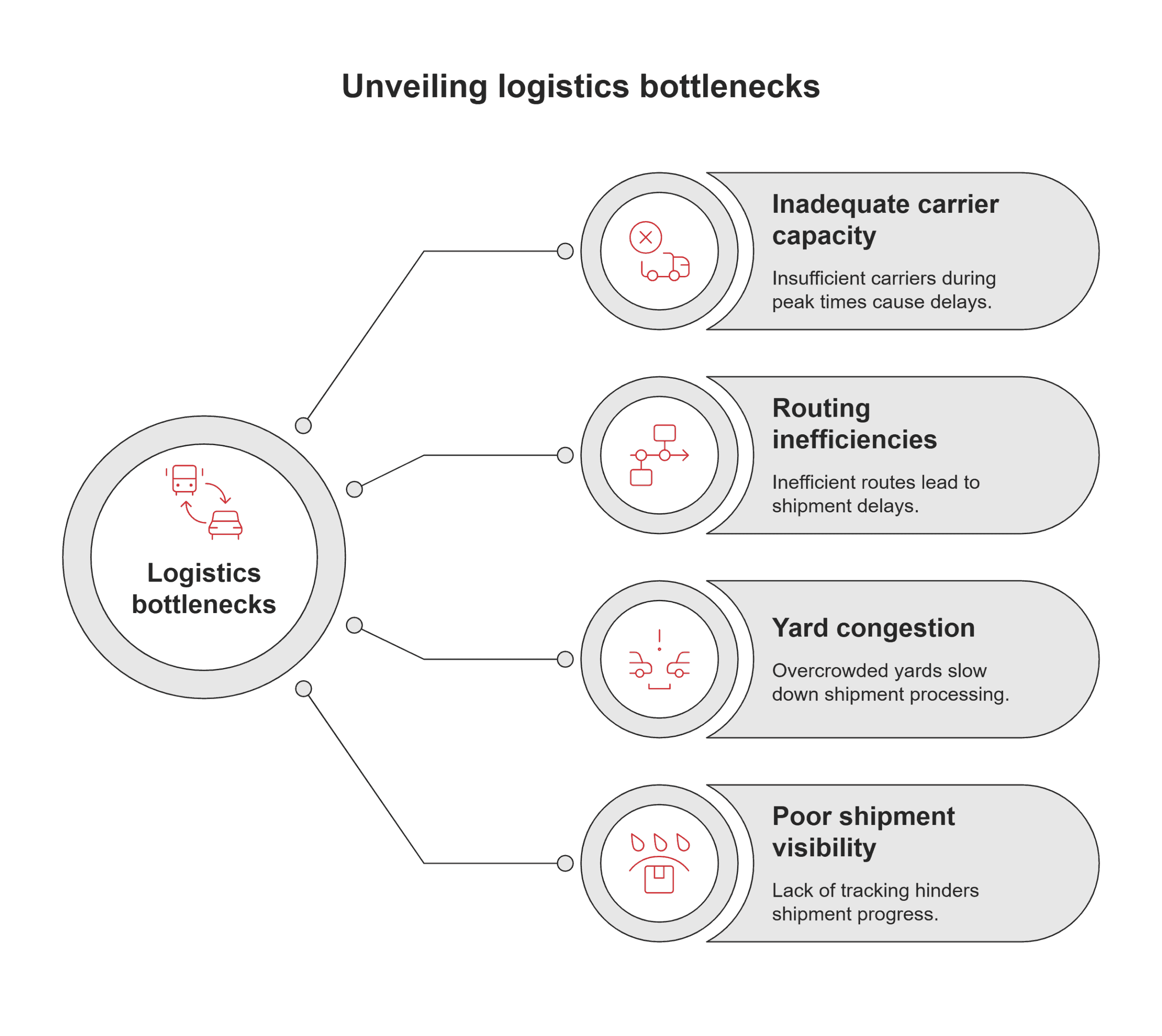
External factors
Uncontrollable factors impacting OTIF include regulatory changes, weather events, economic disruptions, and global crises like pandemics. These external pressures can disrupt supply chain operations and lead to production delays that affect OTIF performance. Building resilience requires scenario planning, diversified supplier networks, flexible logistics arrangements, and robust business continuity plans that maintain operational excellence even during challenging conditions.
Proven strategies to improve OTIF
Achieving consistently high OTIF scores requires systematic approaches that address technology, processes, and partnerships simultaneously. Organizations must focus on comprehensive supply chain management strategies that enhance both operational efficiency and customer satisfaction. Many companies find success by partnering with the best fulfillment companies that specialize in OTIF optimization and have proven track records of delivery excellence.
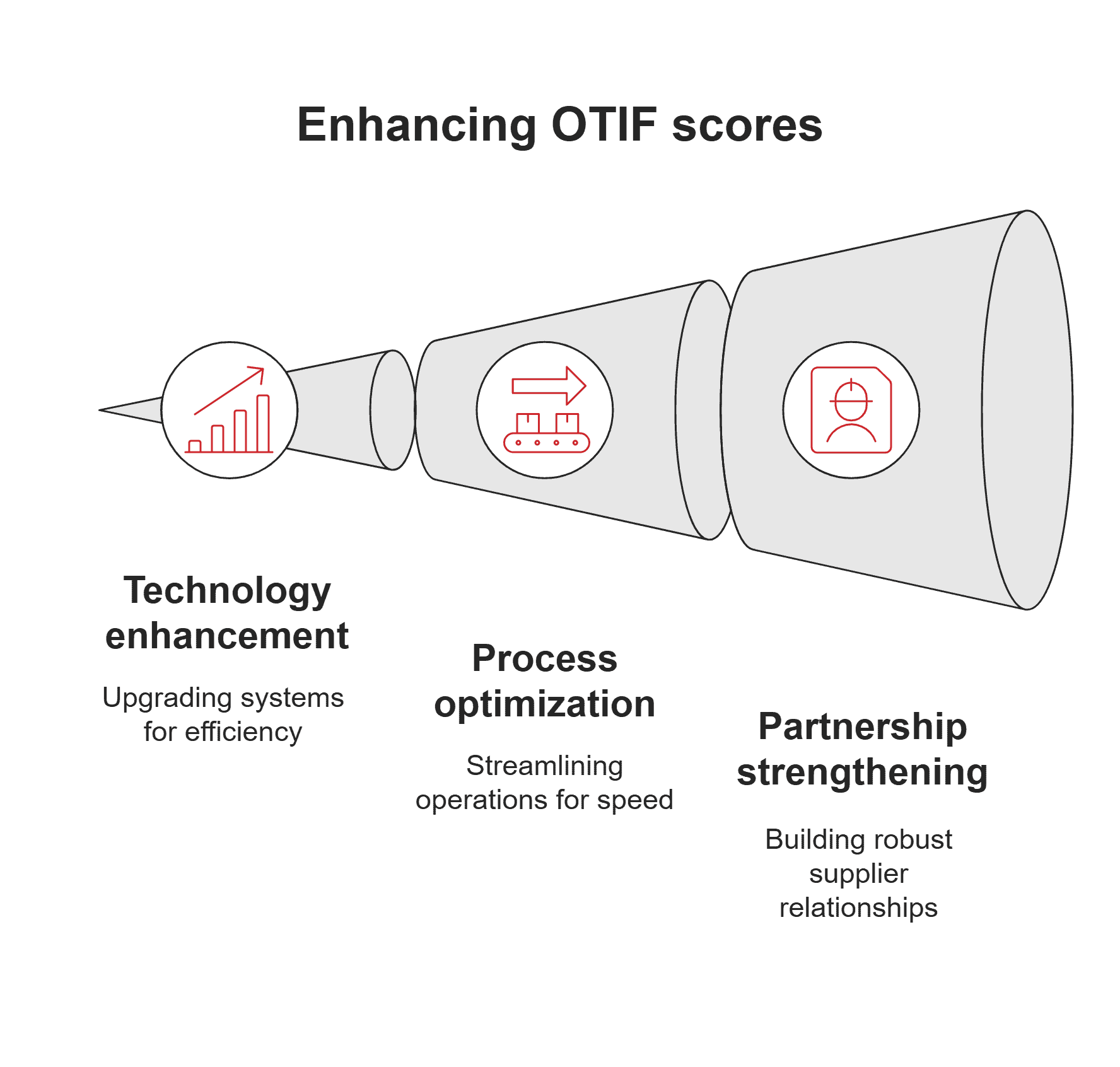
Enhance visibility to prevent OTIF failures
Real-time visibility provides the foundation for proactive management of OTIF performance by enabling early identification of potential problems. GPS tracking, IoT sensors, and automated status updates allow operations teams to spot delays before they become failures, creating time for corrective action. This proactive management approach helps organizations maintain high OTIF scores and meet customer expectations consistently.
Yard management systems optimize dock scheduling, reduce congestion, and streamline loading operations while providing end-to-end visibility into shipment status across distribution centers and the entire supply chain.

PRO TIP: Implement exception-based monitoring that automatically alerts teams when shipments deviate from planned schedules, allowing focus on problems rather than routine tracking. This approach supports effective monitoring of OTIF performance and enables teams to make informed decisions quickly.
Collaborate with suppliers through scorecards and SLAs
Strong supplier relationships drive OTIF improvement through shared accountability and enhanced supplier collaboration. Supplier scorecards track performance metrics, including OTIF contribution, while service level agreements establish clear expectations and consequences for failures. Regular reviews, joint improvement projects, and collaborative forecasting identify and address performance issues before they impact deliveries and your OTIF rate.
Forecast and inventory optimization tips
Advanced forecasting capabilities reduce errors that lead to stockouts and OTIF failures. Key improvement areas include data quality initiatives that ensure accurate demand signals, statistical forecasting models that capture seasonal patterns, collaborative planning processes with major customers, and safety stock optimization that considers supplier reliability and demand variability. ERP systems can provide real-time data integration that supports more accurate forecasting and inventory levels management across your supply chain operations.
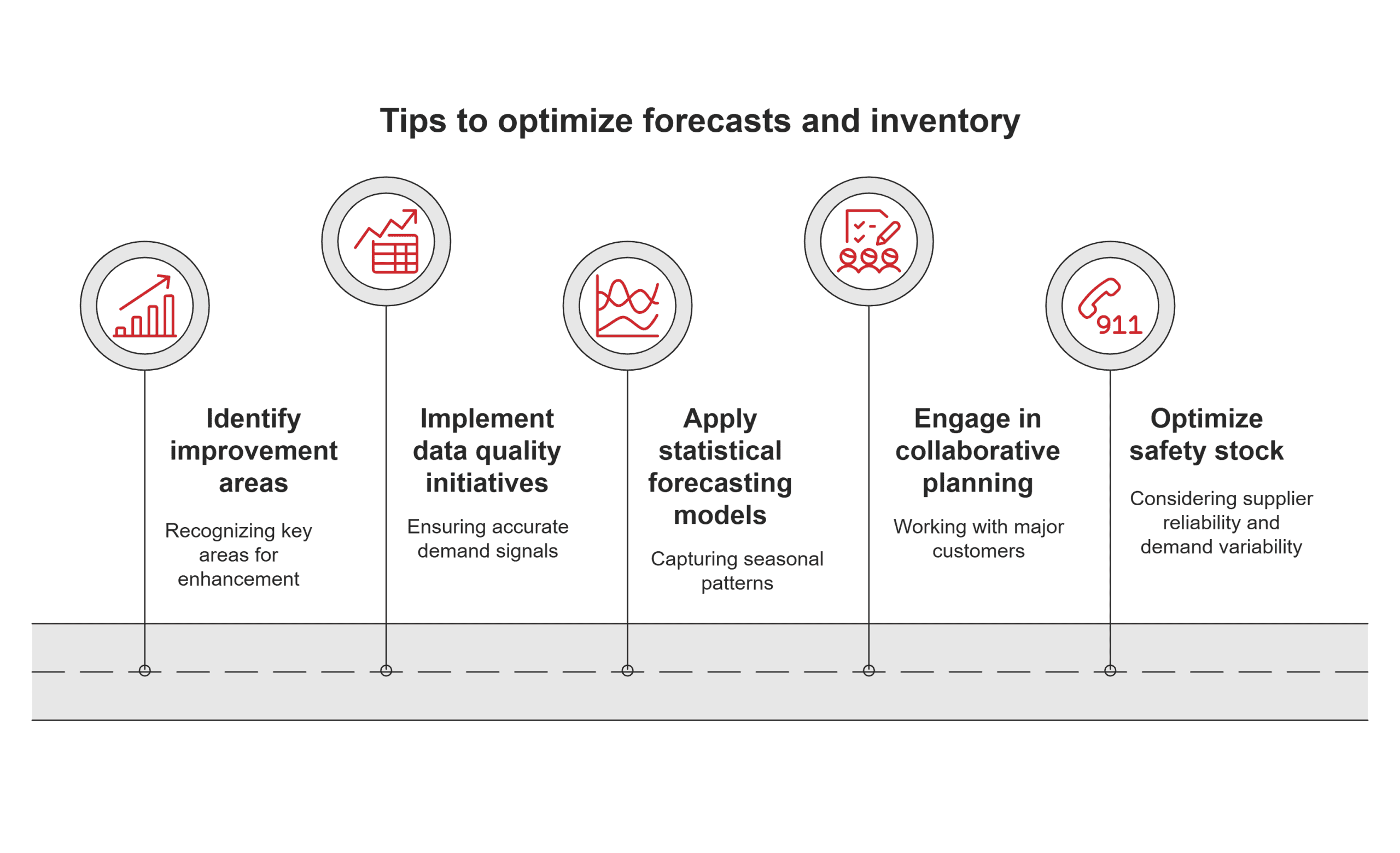
Lean logistics and route optimization
Lean principles eliminate waste and variability in logistics processes that contribute to OTIF failures. Route optimization considers traffic patterns, delivery windows, and vehicle capacities to minimize transportation time while maintaining reliability. Consolidation strategies combine shipments into full truckloads, reducing costs while maintaining delivery performance. These lean approaches help organizations achieve operational excellence and improve their OTIF scores consistently.
Continuous improvement loop for OTIF excellence
Sustainable OTIF improvement requires systematic monitoring and continuous improvement processes that drive long-term success. Plan-Do-Check-Act cycles focus improvement efforts on the highest-impact opportunities. Monthly performance reviews analyze OTIF failures by root cause, enabling targeted improvement initiatives. Organizations should establish clear OTIF goals and implement automated workflows that support consistent performance measurement and improvement tracking to identify trends in supply chain performance.
Companies looking to overhaul their fulfillment operations should understand how to choose a 3PL that can deliver the OTIF performance required by today’s demanding retail environment.
12-point quick audit checklist
Organizations can quickly assess their OTIF readiness using this comprehensive checklist that covers key areas of supply chain management:

Measurement accuracy: Consistent OTIF calculation methodology across all customers using standardized OTIF metrics

Data integration: Real-time data visibility into order status from all systems, including ERP systems

Supplier performance: Regular scorecards and improvement planning with key suppliers to enhance supplier collaboration

Inventory accuracy: Cycle counting programs maintaining high accuracy levels and optimal inventory levels

Demand planning: Statistical forecasting with regular accuracy measurement to minimize lead time variability

Safety stock: Optimized levels based on supplier reliability and demand variability across the entire supply chain

Transportation: Carrier scorecards and backup capacity arrangements to minimize delays and avoid delayed shipments

Yard management: Dock scheduling and congestion monitoring systems at distribution centers

Exception management: Automated alerts for potential OTIF failures supporting proactive management

Root cause analysis: Monthly reviews of failures with corrective actions to identify trends and improve performance

Customer communication: Proactive notification of potential delivery issues to meet customer expectations

Continuous improvement: Cross-functional teams addressing systemic problems and driving operational excellence
For retailers managing multiple sales channels, implementing omnichannel fulfillment strategies ensures consistent OTIF performance across all customer touchpoints while maintaining inventory accuracy and delivery reliability.
FAQs about OTIF

What does OTIF stand for in logistics?
OTIF stands for on-time in-full, a supply chain metric measuring the percentage of orders delivered both on schedule and in complete quantities.










How do you calculate on-time in-full?
To calculate OTIF, divide orders delivered on time and in full by total orders, then multiply by 100 for percentage results. This OTIF KPI calculation provides a clear measure of supply chain performance.










What is a good OTIF score percentage?
A good OTIF score typically ranges from 85-95%, with excellent performance reaching 95-98% depending on industry benchmarks and supply chain complexity.










Why is OTIF important to Walmart suppliers?
Walmart requires a 98% OTIF rate and charges 3% of the cost of goods sold for failures, creating significant financial penalties for poor performance and establishing strict OTIF standards.










How is OTIF different from DIFOT?
OTIF and DIFOT measure similar concepts but may use different calculation methodologies or measurement levels depending on the organization’s supply chain management approach.










What causes low OTIF performance?
Common causes include supplier reliability issues, inaccurate demand forecasting, transportation bottlenecks, inadequate inventory management, and poor order processing that result in late or incomplete deliveries.










How can technology improve OTIF delivery?
Technology improves OTIF through real-time visibility, automated alerts, predictive analytics, ERP systems integration, and streamlined order processing that enhance overall supply chain efficiency. Comprehensive 3PL services often include advanced technology platforms that provide these capabilities to improve OTIF performance.










What penalties exist for poor OTIF performance?
Retailers may impose financial penalties, reduce purchase volumes, or eliminate shelf space for suppliers with consistently low OTIF scores, making it essential to improve OTIF performance continuously.











